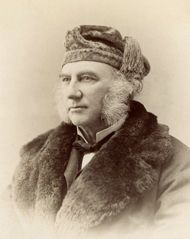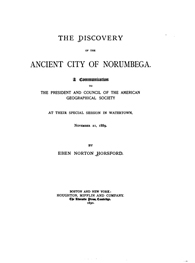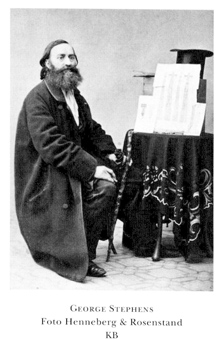 Only one man in American history can claim to have been both a baking-powder revolutionary and a passionate medievalist, and nobody else is going to note this anniversary, so let me do the unasked-for honors: This week marks the 200th birthday of Eben Norton Horsford, the chemist and engineer who spent his golden years trying to convince a highly skeptical world that he had discovered hard, undeniable, multidisciplinary evidence of a thriving Viking city—in Massachusetts.
Only one man in American history can claim to have been both a baking-powder revolutionary and a passionate medievalist, and nobody else is going to note this anniversary, so let me do the unasked-for honors: This week marks the 200th birthday of Eben Norton Horsford, the chemist and engineer who spent his golden years trying to convince a highly skeptical world that he had discovered hard, undeniable, multidisciplinary evidence of a thriving Viking city—in Massachusetts.
If your instinct is to laugh at the idea, please reconsider. As fond as I am of intellectual and architectural follies for their own sake, Horsford’s Viking fixation left us with a useful monument to the weird ways we work out what is or isn’t true, which are often a more subtle folly of their own.
Horsford helped popularize the notion that the Vikings had rambled higgeldy-piggeldy through New England. Evidence would surface much later that the Vikings had hung around Newfoundland, but no one has found proof of their presence farther south, despite its plausibility. Scholars didn’t buy into Horsford’s theories, but he did have his fans, perhaps because he had credentials any popularizer would envy. After Horsford studied civil engineering and taught mathematics, two years in Germany made him one of the first Americans formally trained in chemistry. He then spent sixteen years at Harvard putting his research to practical, profitable use. In the late 1840s or early 1850s, Horsford found that baking powder no longer needed to come in two separate packets of sodium bicarbonate and cream of tartar, the supply and price of which were erratic. Instead, he proposed replacing cream of tartar with calcium acid phosphate, invented a way to manufacture it, got a patent, figured out to how dry it and sell it safely pre-mixed, and became wildly rich. If you’ve baked anything this week, you can thank a Viking-obsessed Harvard chemist.
 And so Eben Horsford—scientist, industrialist, education activist—apparently decided that since he had prospered in mathematics, civil engineering, chemistry, and business, then nothing else human was alien to him. And what were Vikings in America but the next laboratory puzzle to be solved? More than a century after its publication, The Discovery of the Ancient City of Norumbega, Horsford’s book-length 1890 report to the American Geographical Society, is a remarkable read: Horsford is certain that the new scientific techniques of his era have helped him unearth evidence of Vikings in his own back yard. The implications beguile him:
And so Eben Horsford—scientist, industrialist, education activist—apparently decided that since he had prospered in mathematics, civil engineering, chemistry, and business, then nothing else human was alien to him. And what were Vikings in America but the next laboratory puzzle to be solved? More than a century after its publication, The Discovery of the Ancient City of Norumbega, Horsford’s book-length 1890 report to the American Geographical Society, is a remarkable read: Horsford is certain that the new scientific techniques of his era have helped him unearth evidence of Vikings in his own back yard. The implications beguile him:
As we all know, there have been before the world many scores of years, in some instances for as many centuries, certain grand geographical problems, challenging the spirit of research, the love of adventure, or the passion for discovery or conquest. They are such as these: Where was Atlantis? Where was the Ultima Thule? What is there at the North Pole? Was there a Northwest Passage? Where were the Seven Cities? Where were the El Dorado of Raleigh, and the landfall of Leif Erikson, of Columbus, of John Cabot, of Verrazano? And where were Vinland and Norumbega?
“Vinland,” of course, is mentioned in the Viking sagas. “Norumbega” has a later, legendary pedigree as a large and impressive city somewhere south of Nova Scotia, based on maps and travelers’ accounts from 16th-century Europe. Horsford is convinced it was a specifically Viking city, and he’s eager to convince you too—but first he reprints a response from Judge Charles P. Daly, president of the American Geographical Society.
“We have hitherto but inadequately appreciated the Northmen as a race—their adventurous spirit, their capacity, and the degree of civilization to which they had attained in an age when Europe was but emerging from the darkness that had enveloped it for many centuries,” Daly writes, invoking recent scholarship suggesting that the “Aryans” came from Scandinavia, “which would make the Northmen the progenitors of the Greeks, the Romans, and with the exception of one or two races, of all the nations of modern Europe; which, if further researches should establish to be fact, would make them the greatest race in the history of mankind.”
These 19th-century racial notions aren’t surprising, but they’re a good reminder to be wary when authoritative scholars in any age argue primarily from trendy thinking. Horsford isn’t content with his wealth, his impressive accomplishments in chemistry, or his legacy in the kitchens of the world. Driven in part by racial pride, he hopes to use his well-trained mind to disentangle the knotted mysteries of human civilization.
Delving into philology, Horsford is convinced that local place-names—among them Nanset, Naumkeag, Namskaket, and Amosheag—are of “Norse derivation.” He claims that a quirk of Algonquin speech accounts for the name “Norumbega”: The Algonquin, he explains, couldn’t pronounce the “b” sound without putting an “m” in front of it, so the ancient name of Norway, “Norbega,” became “Norumbega.” He bolsters his argument by pointing out that the “mb” quirk is common in African languages, and that plenty of cultures can’t properly pronounce the languages of others. By tinkering plausibly with proto-linguistics, Horsford writes Vikings into the history of Massachusetts. “I may say,” he declares, “there is not a square mile of the basin of the Charles that does not contain incontestable memorials of these people, that will presently be as obvious to others as they now are to me.”
Horsford the philologist is also Horsford the close reader of literary sources. He’s fascinated by an obscure object in the Saga of the Greenlanders: a húsa-snotra that Viking explorer Karlsefni refuses to sell for any price. Even now, nobody knows what a húsa-snotra is. At various times scholars have supposed that it was a carved ship’s ornament, a weather vane, or an astrolabe. Horsford thinks it’s the pans for a set of scales. Whatever it was, a húsa-snotra was said to have been made of North American mǫsurr wood, which Horsford believes is a wet tree with burrs or large warts—just like the trees he sees around the Charles.
Horsford the philologist and Horsford the literary scholar then cede the floor to Horsford the geographer and archaeologist. Using travelers’ descriptions, local history, and colonial sources, he deduces that the Vikings built a fort at the mouth of Stony Brook, which now separates the towns of Waltham and Weston: “I drove directly there,” he proclaims, “and found it on my first visit.” An area paved with boulders fascinates him, and his scrutiny of alluvial soil deposits leads him to believe that a colonial stone dam is the ancient handiwork of Vikings.
It’s really rather amazing: Everywhere Horsford looks, he sees the remnants of a Viking economy—specifically, a system of canals used to float blocks of coveted mǫsurr wood out to waiting ships. His belief in the existence of a thriving wood-block trade prompts him to theorize that every tributary of the Charles must have evidence of a Viking dam or pond either along it or near its mouth—and when he goes looking, he sees what he was predisposed to see. Centuries of Native American and European habitation notwithstanding, nothing along the Charles doesn’t make Horsford see Vikings: “The canals, ditches, deltas, boom-dams, ponds, fish-ways, forts, dwellings, walls, terraces of theater and amphitheater, scattered throughout the Charles, are the monuments I had in mind.”
And so Eben Horsford, profoundly invested in this imagined heritage and desiring to make it tangible, built the rest of us a tower.
* * *
Horsford donated so much money to Wellesley College that in 1886, they flattered him with the naming of Norumbega Hall, a rather un-medieval wooden building that hardly evokes a spirit of exploration or adventure. John Greenleaf Whittier wrote a sonnet for the occasion, one that flatters Horsford’s romanticism while backing away from any promise of authenticity:
Not on Penobscot’s wooded bank the spires
Of the sought City rose, nor yet beside
The winding Charles, nor where the daily tide
Of Naumkeag’s haven rises and retires,
The vision tarried; but somewhere we knew
The beautiful gates must open to our quest,
Somewhere that marvellous City of the West
Would lift its towers and palace domes in view,
And, lo! at last its mystery is made known—
Its only dwellers maidens fair and young,
Its Princess such as England’s Laureate sung;
And safe from capture, save by love alone,
It lends its beauty to the lake’s green shore,
And Norumbega is a myth no more.
It’s a curious poem, full of Wellesley girls re-cast as maidens from medieval romance, but not a single Viking.
 The most lasting physical remnant of Horsford’s folly, though, is the Norumbega Tower, which he built in 1889 at the mouth of Stony Brook to mark the supposed site of the Viking city and fort. Architectural follies are usually their own justification, but Horsford gave more specific reasons than most people who build such things. In The Discovery of the Ancient City of Norumbega he explains, at first graciously:
The most lasting physical remnant of Horsford’s folly, though, is the Norumbega Tower, which he built in 1889 at the mouth of Stony Brook to mark the supposed site of the Viking city and fort. Architectural follies are usually their own justification, but Horsford gave more specific reasons than most people who build such things. In The Discovery of the Ancient City of Norumbega he explains, at first graciously:
It will invite criticism, and so sift out any errors of interpretation into which, sharing the usual fortune of the pioneer, I may have been led.
And then rather less so:
It will help, by reason of its mere presence, and by virtue of the veneration with which the Tower will in time come to be regarded, to bring acquiescence in the fruit of investigation, and so ally the blind skepticism, amounting practically to inverted ambition, that would deprive Massachusetts of the glory of holding the Landfall of Leif Erikson, and at the same time the seat of Europeans in America.
Committed to the falsifiable nature of science, Horsford nonetheless hopes romanticism will encourage future generations to lean his way.
I get a kick out of discredited scholarly theories, but Horsford’s isn’t luridly presented, at least not in this book. He leaves us few nutty-sounding reveries and no McKinley-era equivalent of all-caps exhortations. A man of his time, he turned his polymath’s mind toward the credible techniques of “scientific history” as pioneered in European universities, and off he went on the trail of his preferred past. He found it, as he knew he would. Human prejudices are as consistent as chemistry, if not as quantifiable.
As the 400th anniversary of Columbus’s first voyage approached, a vocal minority of Americans, many of them New England autodidacts inspired by a popular 1837 edition of the Vinland sagas, cringed at the prospect of letting an Italian Catholic in the service of Spain get credit for the European discovery of North America. (My favorite manifestation of their protest: a replica of a Viking ship that floated past the 1893 Columbian Exposition in Chicago.) The racial assumptions of the day helped stoke Horsford’s efforts, but even though few scholars bought into his theories about Vikings on the Charles, contemporaries did consider him rather progressive for his support of women’s education. Horsford’s example just goes to show how ephemeral many social standards will prove, and also how wrong we’re all going to be about something, even the cleverest among us, in the fullness of time.
The man who literally gave us our daily bread longed for a more romantic legacy, one that would link him to his presumed ancestors and affirm their superiority. His 200th birthday is a chance for the rest of us to feel a link to the past, not to some silly racial or tribal forefathers but to anyone whose sincere disorientation humanizes him and humbles us. Let’s all then chase our theories, pore over books, and tromp along riverbeds chasing the boot-prints of phantoms. If your confidence in your own worldview is as unshakeable as Eben Horsford’s, than the Norumbega Tower is a warning: pray that posterity is no less kind to you.

 For all the violence the Vikings unleashed, their enemies and victims might find cold comfort in the torments Americans now inflict on them. We’ve twisted them into beloved ancestors, corny mascots, symbolic immigrants, religious touchstones, comic relief—and, this week,
For all the violence the Vikings unleashed, their enemies and victims might find cold comfort in the torments Americans now inflict on them. We’ve twisted them into beloved ancestors, corny mascots, symbolic immigrants, religious touchstones, comic relief—and, this week,  Likewise, science-fiction fans are forever congratulating themselves for holding the right opinions on such subjects as evolution, but this time they lazily succumbed to fannish fantasies, failing to question a claim that deserved to be pummeled by doubt. I’ve done tons of social-media copywriting, so I get why that blogger just wanted to throw something out there after a holiday to beguile weekend-weary eyeballs—but come on.
Likewise, science-fiction fans are forever congratulating themselves for holding the right opinions on such subjects as evolution, but this time they lazily succumbed to fannish fantasies, failing to question a claim that deserved to be pummeled by doubt. I’ve done tons of social-media copywriting, so I get why that blogger just wanted to throw something out there after a holiday to beguile weekend-weary eyeballs—but come on.